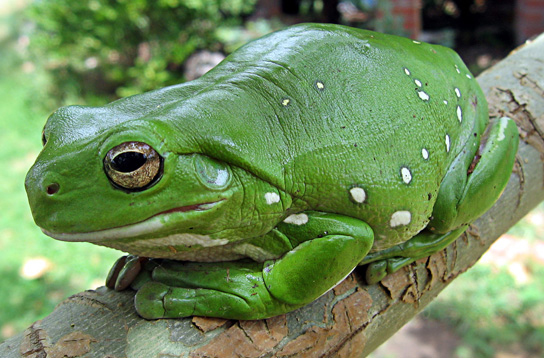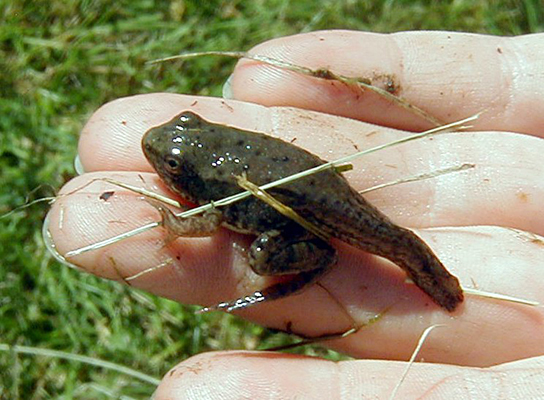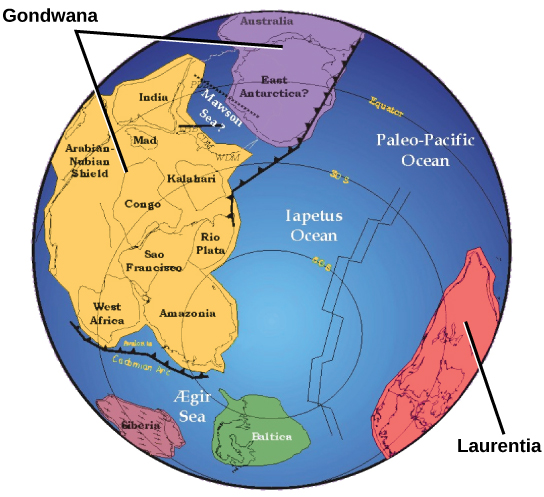| << Chapter < Page | Chapter >> Page > |

Frog eggs are fertilized externally, and like other amphibians, frogs generally lay their eggs in moist environments. A moist environment is required as eggs lack a shell and thus dehydrate quickly in dry environments. Frogs demonstrate a great diversity of parental behaviors, with some species laying many eggs and exhibiting little parental care, to species that carry eggs and tadpoles on their hind legs or backs. The life cycle of frogs, as other amphibians, consists of two distinct stages: the larval stage followed by metamorphosis to an adult stage. The larval stage of a frog, the tadpole , is often a filter-feeding herbivore. Tadpoles usually have gills, a lateral line system, long-finned tails, and lack limbs. At the end of the tadpole stage, frogs undergo metamorphosis into the adult form ( [link] ). During this stage, the gills, tail, and lateral line system disappear, and four limbs develop. The jaws become larger and are suited for carnivorous feeding, and the digestive system transforms into the typical short gut of a predator. An eardrum and air-breathing lungs also develop. These changes during metamorphosis allow the larvae to move onto land in the adult stage.

An estimated 185 species comprise caecilians , a group of amphibians that belong to the order Apoda. Although they are vertebrates, a complete lack of limbs leads to their resemblance to earthworms in appearance. They are adapted for a soil-burrowing or aquatic lifestyle, and they are nearly blind. These animals are found in the tropics of South America, Africa, and Southern Asia. They have vestigial limbs, evidence that they evolved from a legged ancestor.

During the early Paleozoic, the amount of carbon dioxide in the atmosphere was much greater than it is today. This may have begun to change later, as land plants became more common. As the roots of land plants began to infiltrate rock and soil began to form, carbon dioxide was drawn out of the atmosphere and became trapped in the rock. This reduced the levels of carbon dioxide and increased the levels of oxygen in the atmosphere, so that by the end of the Paleozoic, atmospheric conditions were similar to those of today.
As plants became more common through the latter half of the Paleozoic, microclimates began to emerge and ecosystems began to change. As plants and ecosystems continued to grow and become more complex, vertebrates moved from the water to land. The presence of shoreline vegetation may have contributed to the movement of vertebrates onto land. One hypothesis suggests that the fins of aquatic vertebrates were used to maneuver through this vegetation, providing a precursor to the movement of fins on land and the development of limbs. The late Paleozoic was a time of diversification of vertebrates, as amniotes emerged and became two different lines that gave rise, on one hand, to mammals, and, on the other hand, to reptiles and birds. Many marine vertebrates became extinct near the end of the Devonian period, which ended about 360 million years ago, and both marine and terrestrial vertebrates were decimated by a mass extinction in the early Permian period about 250 million years ago.
View Earth’s Paleogeography: Continental Movements Through Time to see changes in Earth as life evolved.
As tetrapods, most amphibians are characterized by four well-developed limbs, although some species of salamanders and all caecilians are limbless. The most important characteristic of extant amphibians is a moist, permeable skin used for cutaneous respiration. The fossil record provides evidence of amphibian species, now extinct, that arose over 400 million years ago as the first tetrapods. Amphibia can be divided into three clades: salamanders (Urodela), frogs (Anura), and caecilians (Apoda). The life cycle of frogs, like the majority of amphibians, consists of two distinct stages: the larval stage and metamorphosis to an adult stage. Some species in all orders bypass a free-living larval stage.

Notification Switch
Would you like to follow the 'Biology' conversation and receive update notifications?